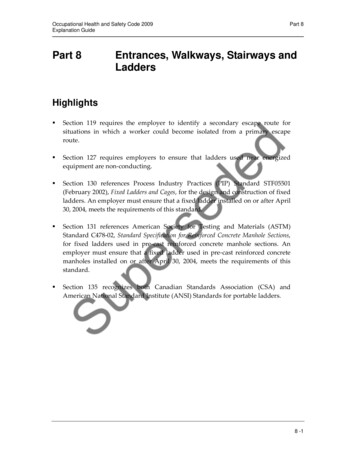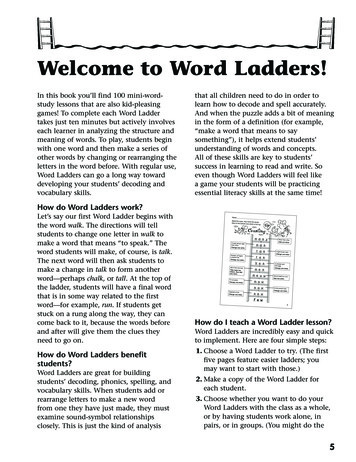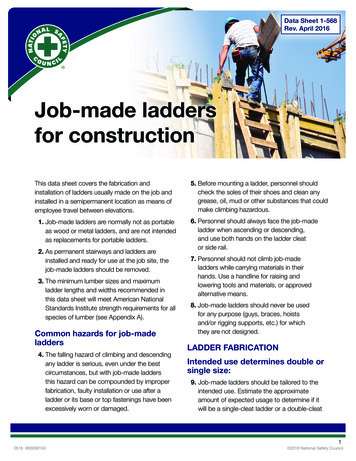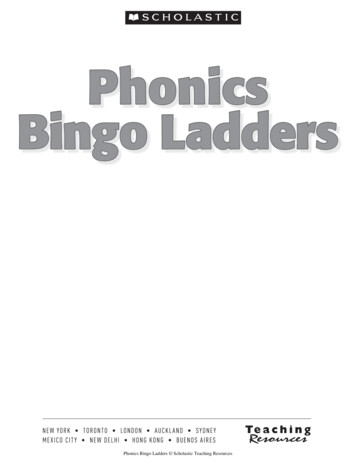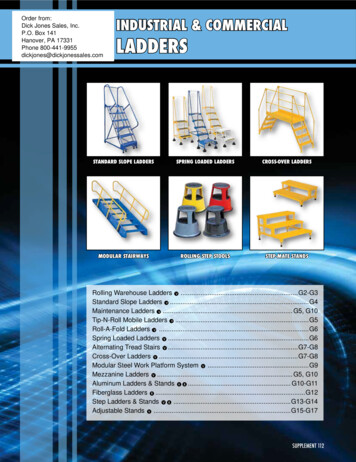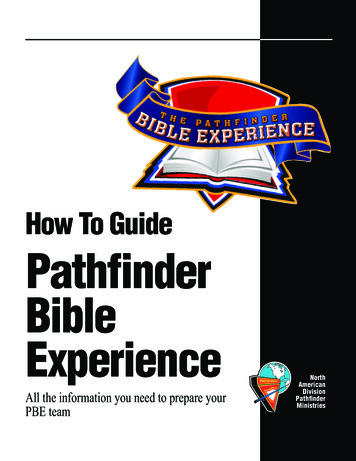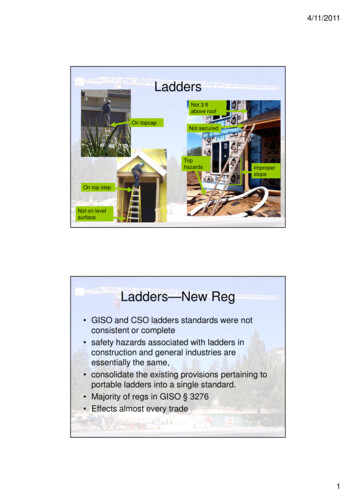
Transcription
4/11/2011LaddersNot 3 ftabove roofOn topcapNot securedTriphazardsImproperslopeOn top stepNot on levelsurfaceLadders—New Reg GISO and CSO ladders standards were notconsistent or complete safety hazards associated with ladders inconstruction and general industries areessentially the same, consolidate the existing provisions pertaining toportable ladders into a single standard. Majority of regs in GISO § 3276 Effects almost every trade1
4/11/2011§3276. Use of Ladders.(a) Scope. design, construction, selection,care, and use of all self-supporting and nonself-supporting portable ladders Self SupportingNonNon--SelfSupportingTwo manSupporting§3276. Portable Ladders.(a) Scope. This section is intended to prescribe rules andestablish minimum requirements for the design,construction, selection, care, and use of all selfsupporting and non-self-supporting portableladders, in order to insure safety under normal conditionsof usage. This section does not apply to ladder type stepstools or other types of step stools except– for the definition of “step stool (ladder type)” insubsection (b) and– the design and construction requirements ofsubsection (c)(5).2
4/11/2011 §3276. Use of Ladders.(b) Definitions.– Ladders. A ladder is an appliance usuallyconsisting of two side rails joined at regularintervals by crosspieces called steps, rungs, orcleats, on which a person may step inascending or descending.(c) Design and Construction.ANSI A14.1-2007, Ladders – WoodANSI A14.2-2007, Ladders - MetalANSI A14.5-2007, Ladders - Reinforced Plastic §3276. Use of Ladders.(c) Design and Construction.(4) Portable special purpose ladders that are notcovered by one of the ANSI A14 standardsreferenced in this section shall be designed andconstructed in accordance with soundengineering principles and approved perSection 3206.(5) Ladder type step stools shall be designed 3
4/11/2011§3276. Use of Ladders.(d) Selection.– purpose for which theladder is designed.– the person, the task, andthe environment– length or height required,– load & the duty rating,– worker position to the taskto be performed§3276. Use of Ladders.– Duty RatingLadderSpecial DutyExtra IIIIIIWorking Load (lbs)3753002502252004
4/11/2011§3276(e) Care, Use, Inspectionand Maintenance of Ladders.(1) Maintenance.–maintained in good condition at all times(2) Inspection.–inspected by a qualified person for visible defectsfrequently(3) Damaged Ladders––withdrawn from service for repair or destructionLadders with broken or missing steps, rungs, cleats,safety feet, side rails, or other defects shall not beused.§3276(e) Care, Use, Inspectionand Maintenance of Ladders.(4) Cleaning–free of oil, grease, or slippery materials(5) Surface Coatings–Wood ladders shall not be painted(6) Loading–shall not be overloaded5
4/11/2011§3276(e) Care, Use, Inspectionand Maintenance of Ladders.(7) Footing Support.– placed on a secure and levelfooting.– Ladders shall not be placedon boxes, barrels or otherunstable– Ladders shall not be used onice, snow or slippery surfacesunless §3276(e) Care, Use, Inspectionand Maintenance of Ladders.(8) Top Support.– placed with the two rails supported equally, unless asingle support attachment is provided and used.6
4/11/2011§3276(e) Care, Use, Inspectionand Maintenance of Ladders.(9) Angle of Inclination.– horizontal distance from the topsupport to the foot of the ladder isone-quarter of the working length ofthe ladder– The ladder shall be so placed as toprevent slipping, or it shall be tied,blocked, held, or otherwise securedto prevent slipping.– Ladders shall not be used in ahorizontal position as platforms,runways, or scaffolds unlessdesigned for such use.§3276(e) Care, Use, Inspectionand Maintenance of Ladders.(10) Access to Elevated Work Areas.– when two or more separateladders are used to reach anelevated work area, theladders shall be offset with aplatform or landing betweenthe ladders.7
4/11/2011§3276(e) Care, Use, Inspectionand Maintenance of Ladders.(11) Access to Landings.– the side rails shall extend not lessthan 36 inches above the upperlanding surface– when such an extension is notpossible, then the ladder shall be secured at its topto a rigid support that will not deflect, and a grasping device, such as a grab-rail,shall be provided to assist employees inmounting and dismounting the ladder§3276(e) Care, Use, Inspectionand Maintenance of Ladders.(12) Fastening Together.– not be tied or fastened together(13) Erection of Extension Ladders.– top section is above and resting on thebottom section with the rung locksengaged.(14) Ladder Placement.– not be placed in passageways,doorways, driveways, unless protectedby barricades or guards.8
4/11/2011§3276(e)(15) Climbing andWorking on Ladders.(A) The employee shall climb or work with the bodynear the middle of the step or rung and shallnot overreach from this position. When necessary to avoid overreaching, theemployee shall descend and reposition theladder. When it is not practical to work with the bodynear the middle of the step or rung, the laddershall be secured to the top support, and theemployee shall be protected by a personal fallprotection system.9
4/11/2011§3276(e)(15) Climbing andWorking on Ladders.(B) prohibited from carrying equipment ormaterials(C) face the ladder and maintain contactwith the ladder at three-points at all times.NOTE: Contact with the ladderat three points means two feetand one hand, or two handsand one foot which is safelysupporting the user's weight.§3276(e)(15) Climbing andWorking on Ladders.(D) An employee shall not be permitted to standand work on the top 3 rungs of a single orextension ladder unless (E) Employees shall not stand on the topcap or thestep below the topcap of a step ladder.10
4/11/2011§3276(e)(15) Climbing andWorking on Ladders.(F) Cross-bracing on the rear section of stepladders shall not be used for climbing (G) Ladders shall not be moved, shifted, orextended while occupied, unless theladder is designed and recommended forthis purpose by the manufacturer.§3276(e)(16)Prohibited Uses.(A) Ladders shall not be used as abrace, skid, guy or gin pole, gangway, or for other uses than that forwhich they were intended, .(B) Planks shall not be used on the topstep or topcap of step ladders.(C) Step ladders shall not be used assingle ladders or in the partiallyclosed position.11
4/11/2011§3276(e)(16)Prohibited Uses.Ladder TypeMax Length (Ft)Step ladder.20Two-section extension ladder (wood).60Two-section extension ladder (metal).48Three-section extension ladder (metal).60Two-section extension ladder (reinforced plastic).72Trestle ladder.20Extension trestle ladder base section.20Extension trestle ladder extension section.20Painter's step ladder.12Mason's ladder.40Cleat ladder.30Trolley ladder or side-rolling ladder.20Single ladder.30§3276(e) Care, Use, Inspectionand Maintenance of Ladders.(17) Portable rung ladders with reinforced railsshall be used only with the metal reinforcementon the under side.(18) Electrical Hazards. Non-conductive laddersshall be used in locations where (19) The area around the top and bottom of aladder shall be kept clear.12
4/11/2011§3276. Use of Ladders.(f) Employee Training. Before an employee uses aladder, the employee shall be provided training(1) Importance of using ladders safely,(2) Selection, (type length capacity)(3) Maintenance, inspection, and removal(4) Erecting ladders,(5) Climbing and working on ladders,(6) Factors contributing to falls, (7) Prohibited uses13
ANSI A14.5-2007, Ladders - Reinforced Plastic §3276. Use of Ladders. (c) Design and Construction. (4) Portable special purpose ladders that are not covered by one of the ANSI A14 standards referenced in this section shall be designed and constructed in accordance with sound engineering principles and approved per Section 3206. (5) Ladder type step stools shall be designed 4/11/2011 4 .
